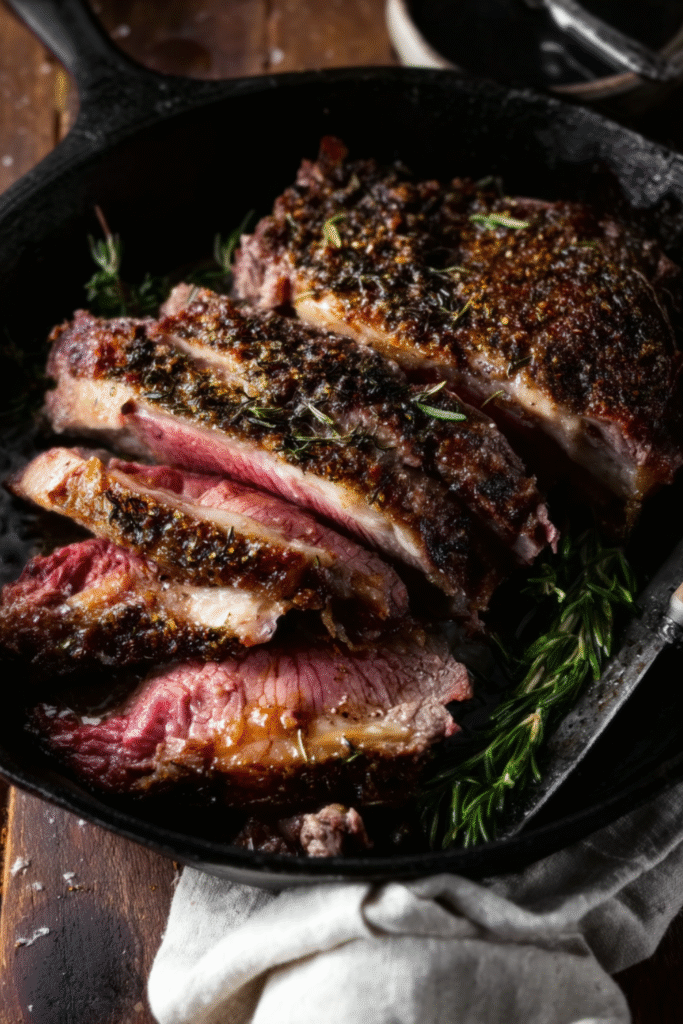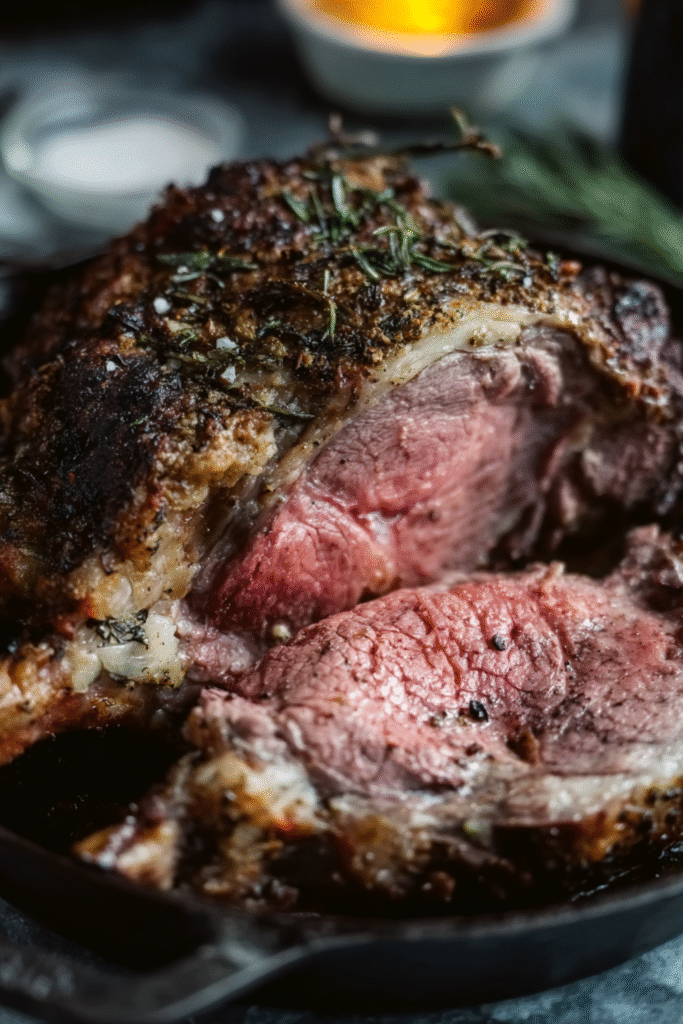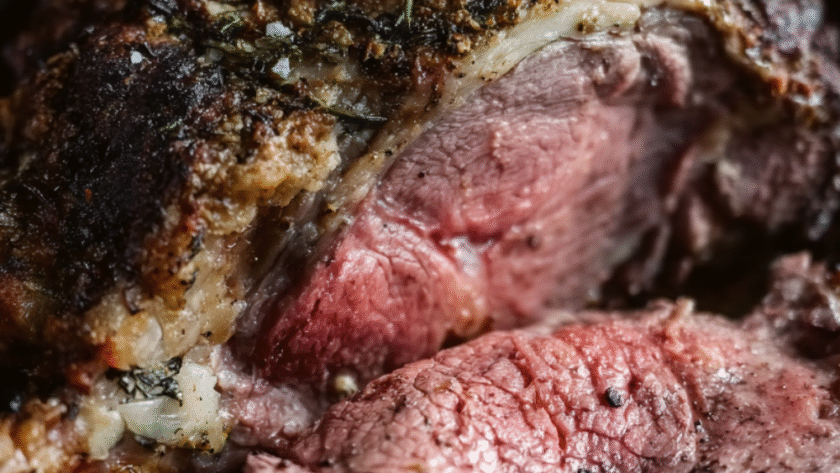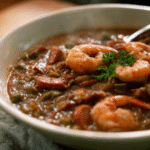This Paula Deen Prime Rib Recipe is a perfect and juicy recipe, which is seasoned with fresh garlic and rosemary. It’s a restaurant-quality dish, ready in about 2 hours plus resting time.
Paula Deen Prime Rib Recipe Ingredients
- 5 pounds beef prime rib (bone-in or boneless)
- Sea salt
- 2 teaspoons freshly ground black pepper
- 2 teaspoons fresh rosemary, minced
- 1 teaspoon fresh thyme, minced
- 8 cloves garlic, minced
- 1/4 cup olive oil
- Horseradish, for serving (optional)
How To Make Paula Deen Prime Rib
- Bring Meat to Room Temperature: Remove the prime rib from the refrigerator about one hour before cooking. Season it generously on all sides with sea salt, then cover it loosely with plastic wrap and let it sit on the counter. Bringing the roast to room temperature ensures it will cook more evenly.
- Prepare Oven and Seasonings: Adjust your oven rack so the prime rib will sit in the center of the oven. Preheat the oven to a high temperature of 500°F. In a small bowl, mix together 1 ½ teaspoons of salt, the black pepper, rosemary, thyme, minced garlic, and olive oil to create a paste.
- Season the Roast: Pat the room-temperature roast dry with paper towels. Spoon the garlic and herb mixture over the entire surface of the prime rib, rubbing it onto all sides.
- Position the Roast: For a bone-in roast, place it in a cast iron skillet or roasting pan with the bone-side down, as the bones will act as a natural rack. For a boneless roast, place it on a small metal rack inside the pan.
- Sear and Roast: Place the prime rib in the 500°F oven and roast for 15 minutes. This initial high heat creates a beautiful crust. Then, reduce the oven temperature to 325°F and continue roasting until your desired level of doneness is reached.
- Check the Temperature: Use a meat thermometer inserted into the thickest part of the roast, avoiding any bone. Remove the roast from the oven when it is 5-10 degrees below your target temperature, as it will continue to cook while it rests.
- Rare: Pull at 120°F (approx. 10-12 min/pound)
- Medium Rare: Pull at 130°F (approx. 13-14 min/pound)
- Medium: Pull at 140°F (approx. 14-15 min/pound)
- Rest the Roast: Transfer the roast to a cutting board and tent it loosely with aluminum foil. Let it rest for at least 30 minutes. This is a crucial step that allows the juices to redistribute throughout the meat.
- Carve and Serve: If using a bone-in roast, slice the bones away from the meat. Carve the roast against the grain into ½-inch thick slices. Serve immediately with horseradish, if desired.

Recipe Tips
- Bone-in vs. Boneless? For the most flavor, a bone-in prime rib is recommended. The bones add flavor and moisture as it cooks. You can ask your butcher to cut the bone rack off and tie it back on, which makes for easy removal before carving.
- How do I get an even cook? Don’t skip the step of bringing the meat to room temperature. A cold roast will cook unevenly, with the outside being overdone before the inside reaches temperature.
- Why is resting the meat so important? Resting the prime rib after cooking is non-negotiable. It allows the juices, which have been driven to the center during cooking, to redistribute throughout the roast. Slicing it too early will cause all those delicious juices to run out onto the cutting board, resulting in dry meat.
- How do I use a meat thermometer correctly? Insert the thermometer into the thickest part of the roast, making sure the tip is not touching any bone, as this will give an inaccurate reading. Checking the temperature is the only way to guarantee a perfectly cooked prime rib.
What To Serve With Prime Rib
This show-stopping main course pairs beautifully with classic steakhouse sides:
- Creamy Mashed Potatoes or a Loaded Baked Potato
- Roasted Asparagus or Green Beans
- Creamed Spinach
- Yorkshire Pudding or soft dinner rolls
- A full-bodied red wine like Cabernet Sauvignon or Merlot
How To Store Prime Rib
Refrigerate: Store leftover sliced prime rib in an airtight container in the refrigerator for up to 3 days. Reheat: Reheat slices gently in a skillet with a splash of beef broth over low heat to prevent them from drying out.
Prime Rib Nutrition Facts
- Calories: 729kcal
- Protein: 31g
- Fat: 66g
- Carbohydrates: 1g
- Sodium: 102mg
Nutrition information is estimated and may vary based on ingredients and cooking methods used.
FAQs
Fresh herbs provide the best flavor, but you can substitute dried herbs in a pinch. Use about one-third the amount of dried herbs as you would fresh (e.g., about 3/4 teaspoon of dried rosemary).
Toughness is usually a result of overcooking or not letting the meat rest long enough. Using a meat thermometer is the best way to avoid overcooking. Slicing with the grain, instead of against it, can also make the meat seem tougher to chew.
The “grain” refers to the direction that the muscle fibers are aligned. To slice against the grain, you should look at the meat and identify the direction of these fibers, then slice perpendicular to them. This shortens the muscle fibers, making each bite much more tender.
Try More Recipes:
- Paula Deen Mac and Cheese Casserole Recipe
- Paula Deen Creamed Corn Recipe
- Paula Deen Beef Stew Recipe

Paula Deen Prime Rib Recipe
Description
A tender, juicy, and perfectly seasoned prime rib roast with a garlic-herb crust, cooked to perfection for a show-stopping holiday or dinner party main course.
Ingredients
Instructions
- Let prime rib rest at room temperature for 1 hour after seasoning with salt.
- Preheat oven to 500°F. Mix pepper, herbs, garlic, and olive oil to form a paste.
- Pat the roast dry and rub the herb paste all over it. Place in a roasting pan (bone-side down or on a rack).
- Roast at 500°F for 15 minutes to sear the outside.
- Reduce oven temperature to 325°F and continue roasting until a thermometer reads 5-10° below your desired doneness.
- Remove from oven, tent with foil, and let rest for at least 30 minutes.
- Carve against the grain and serve immediately.
Notes
- Use a meat thermometer for guaranteed perfect results. Remove the roast from the oven when it’s 5-10°F below your final target temperature.
- Resting the meat is crucial for a juicy roast; do not skip this step.
- For the best flavor, choose a bone-in prime rib.
- Slicing against the grain makes each bite more tender.



